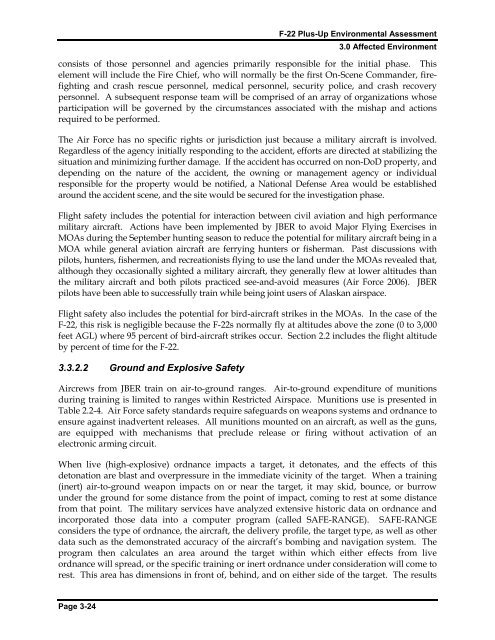F-22 Plus-Up Environmental Assessment - Joint Base Elmendorf ...
F-22 Plus-Up Environmental Assessment - Joint Base Elmendorf ...
F-22 Plus-Up Environmental Assessment - Joint Base Elmendorf ...
You also want an ePaper? Increase the reach of your titles
YUMPU automatically turns print PDFs into web optimized ePapers that Google loves.
F-<strong>22</strong> <strong>Plus</strong>-<strong>Up</strong> <strong>Environmental</strong> <strong>Assessment</strong><br />
3.0 Affected Environment<br />
consists of those personnel and agencies primarily responsible for the initial phase. This<br />
element will include the Fire Chief, who will normally be the first On-Scene Commander, firefighting<br />
and crash rescue personnel, medical personnel, security police, and crash recovery<br />
personnel. A subsequent response team will be comprised of an array of organizations whose<br />
participation will be governed by the circumstances associated with the mishap and actions<br />
required to be performed.<br />
The Air Force has no specific rights or jurisdiction just because a military aircraft is involved.<br />
Regardless of the agency initially responding to the accident, efforts are directed at stabilizing the<br />
situation and minimizing further damage. If the accident has occurred on non-DoD property, and<br />
depending on the nature of the accident, the owning or management agency or individual<br />
responsible for the property would be notified, a National Defense Area would be established<br />
around the accident scene, and the site would be secured for the investigation phase.<br />
Flight safety includes the potential for interaction between civil aviation and high performance<br />
military aircraft. Actions have been implemented by JBER to avoid Major Flying Exercises in<br />
MOAs during the September hunting season to reduce the potential for military aircraft being in a<br />
MOA while general aviation aircraft are ferrying hunters or fisherman. Past discussions with<br />
pilots, hunters, fishermen, and recreationists flying to use the land under the MOAs revealed that,<br />
although they occasionally sighted a military aircraft, they generally flew at lower altitudes than<br />
the military aircraft and both pilots practiced see-and-avoid measures (Air Force 2006). JBER<br />
pilots have been able to successfully train while being joint users of Alaskan airspace.<br />
Flight safety also includes the potential for bird-aircraft strikes in the MOAs. In the case of the<br />
F-<strong>22</strong>, this risk is negligible because the F-<strong>22</strong>s normally fly at altitudes above the zone (0 to 3,000<br />
feet AGL) where 95 percent of bird-aircraft strikes occur. Section 2.2 includes the flight altitude<br />
by percent of time for the F-<strong>22</strong>.<br />
3.3.2.2 Ground and Explosive Safety<br />
Aircrews from JBER train on air-to-ground ranges. Air-to-ground expenditure of munitions<br />
during training is limited to ranges within Restricted Airspace. Munitions use is presented in<br />
Table 2.2-4. Air Force safety standards require safeguards on weapons systems and ordnance to<br />
ensure against inadvertent releases. All munitions mounted on an aircraft, as well as the guns,<br />
are equipped with mechanisms that preclude release or firing without activation of an<br />
electronic arming circuit.<br />
When live (high-explosive) ordnance impacts a target, it detonates, and the effects of this<br />
detonation are blast and overpressure in the immediate vicinity of the target. When a training<br />
(inert) air-to-ground weapon impacts on or near the target, it may skid, bounce, or burrow<br />
under the ground for some distance from the point of impact, coming to rest at some distance<br />
from that point. The military services have analyzed extensive historic data on ordnance and<br />
incorporated those data into a computer program (called SAFE-RANGE). SAFE-RANGE<br />
considers the type of ordnance, the aircraft, the delivery profile, the target type, as well as other<br />
data such as the demonstrated accuracy of the aircraft’s bombing and navigation system. The<br />
program then calculates an area around the target within which either effects from live<br />
ordnance will spread, or the specific training or inert ordnance under consideration will come to<br />
rest. This area has dimensions in front of, behind, and on either side of the target. The results<br />
Page 3-24
















